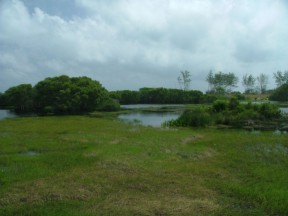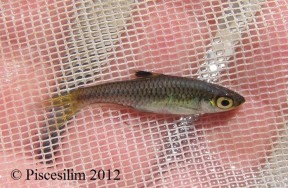Brevibora cheeya
Etymology
Brevibora: from the Latin brevis, meaning ‘shorts, and ‘bora’ from Rasbora, a genus from which Brevibora was split, in allusion to the few predorsal vertebrae compared to related species.
cheeya: Cheeya and Beiya, are two Chinese deities who hunt ghosts for Yama; “chee” and “bei” mean seven and eight, respectively, and “ya” is an honorable title for a respected person. Cheeya is tall and Beiya is short; in allusion to this species’ relatively larger size as compared to B. dorsiocellata.
Classification
Order: Cypriniformes Family: Cyprinidae
Distribution
Recorded from the states of Selangor, Terengganu, Pahang and Johor in Peninsular Malaysia, Jambi and Riau provinces in Sumatra (Indonesia) and the island of Banka which lies off Sumatra’s southeastern coast.
Type locality is ‘Terengganu, Rantau Abang, 56 kilometers to Kuala Terengganu, Malaysia’.
Habitat
The type locality is described as flowing slowly through ‘coastal heath forest’ among stands of a Melaleuca species (myrtle).
The substrate was a mixture of sand and peat and the water acidic (pH 4.5 in February 2009).
Fish diversity was high with sympatric species including Boraras maculatus, Cyclocheilichthys apogon, Osteochilus spilurus, Parachela maculicauda, P. oxygastroides, Rasbora einthovenii, R. trilineata, Desmopuntius johorensis, Trigonopoma gracile, T. pauciperforatum, Lepidocephalichthys furcatus, Pangio alcoides, P. semicincta, Kryptopterus macrocephalus, Ompok leiacanthus, Wallago leerii, Hemibagrus nemurus, Pseudomystus leiacanthus, Clarias batrachus, C. meladerma, Parakysis verrucosa, Aplocheilus panchax, Hemirhamphodon pogonognathus, Monopterus albus, Nandus nebulosus, Pristolepis grooti, Belontia hasselti, Betta imbellis, B. waseri, Luciocephalus pulcher, Parosphromenus paludicola, Trichopodus leerii, T. trichopterus, Trichopsis vittata, Channa bankanensis, C. lucius and C. striata.
Maximum Standard Length
40 – 55 mm.
Aquarium SizeTop ↑
An aquarium with base dimensions of at least 80 ∗ 30 cm is suggested.
Maintenance
Choice of décor is not as critical as water quality although this species does look particularly effective in a well-planted tank with a dark substrate.
To see it at its best a natural-style set-up can also make an interesting project.
In this case a soft, sandy substrate is probably the best choice to which can be added a few driftwood roots and branches placed in such a way that plenty of shady spots are formed.
If you can’t find driftwood of the desired shape common beech or oak is safe to use if thoroughly dried and stripped of bark.
The addition of dried leaf litter further emphasises the natural feel and as well as offering even more cover for the fish brings with it the growth of microbe colonies as decomposition occurs.
Such microorganisms can provide a valuable secondary food source for fry whilst the tannins and other chemicals released by the decaying leaves are thought to be beneficial for blackwater fish species.
Leaves can be left in the tank to break down fully or removed and replaced every few weeks.
This species will do best under fairly dim lighting although this does not preclude the use of aquatic plants with Microsorum, Taxiphyllum or Cryptocoryne spp. all able to survive in such conditions.
Water Conditions
Temperature: 20 – 25 °C
pH: 4.0 – 7.0
Hardness: 18 – 143 ppm
Diet
Likely to be a micropredator feeding on small insects, worms, crustaceans and other zooplankton in nature.
In the aquarium it will accept dried foods of a suitable size but should ideally should be offered daily meals of small live and frozen fare such as Daphnia, Artemia and suchlike.
Behaviour and CompatibilityTop ↑
This species makes an ideal addition to a peaceful community set-up which could include similarly-sized rasboras, barbs, loaches, and certain anabantoids, but it does not compete well with much larger or more boisterous species.
That said, it has been observed to behave aggressively towards its congener B. dorsiocellata while leaving other tankmates alone (S. Grant, pers. comm.).
It’s a schooling fish by nature and should be kept in a group of at least 8-10 specimens if possible.
Maintaining decent numbers will not only make the fish less nervous but result in a more effective, natural-looking display, while males will also display their best colours as they compete with one other for female attention.
Sexual Dimorphism
Mature females are noticeably rounder-bellied and probably a little larger than males.
Reproduction
Unrecorded.
NotesTop ↑
This species is very rare in the trade and is normally imported only as bycatch among shipments of other fishes.
It can be told apart from its well-known congener B. dorsiocellata by a combination of characters as follows: lateral line complete (25-30 pored scales vs. 4-9); more scales in the lateral row (29-32 vs. 25-27); larger adult size (39.0 mm SL vs. 23.0 mm SL); larger head and prepectoral length (head length 28.5-30.0% SL, vs. 24.4-27.9; prepectoral length 29.6-32.9% SL, vs. 25.8-28.8). B. exilis Liao & Tan, 2014 is distinguished from the other species by the following characters: 10 circumpeduncular scales (vs. 12); anterior outline of dorsal-fin blotch ranging from 2nd unbranched ray to first four or five branched rays with transparent inter-radial membrane between 1st and 2nd unbranched rays (vs. blotch extending from 1st unbranched ray and inter-radial membrane between 1st and 2nd unbranched rays not hyaline), and relatively more slender body (body depth 19.3-24.7 % SL, vs. 24.4-26.7).
Several years prior to its description Grant (2002) suggested that specimens of B. cheeya in the aquarium trade might represent the subspecies Rasbora dorsiocellata macrophthalma (Meinken, 1951) which was described using a specimen from the aquarium trade from the vague locality ‘Malay Peninsula’.
Liao and Tan (2011) argue out that the type specimen of R. d. macrophthalma has been lost and that even if proved a genuine species the validity of B. cheeya would be unaffected since it possesses a complete lateral line (vs. incomplete in R. d. macrophthalma).
The genus can be distinguished by the following combination of characters: palatine process rectangular with a narrow base and lacking projection; a median black blotch in the dorsal-fin; low number of predorsal vertebrae (8-9, 6:3 vs. more than 9 in other rasborin genera).
Rainboth’s ‘Fishes of the Cambodian Mekong’ characterised members of Rasbora by possession of an unbranched, non-spiny first dorsal-fin ray and seven soft dorsal rays, origin of the dorsal-fin in the middle of the body, five branched anal-fin rays, a small mouth not extending below the eye and a lack of barbels.
It’s long been recognised as a polyphyletic lineage and Liao et al. (2010) proposed a number of taxonomical changes based on the results of their phylogenetic analysis.
The authors found species of rasborin genera to represent a monophyletic grouping existing in six clades, and erected four new genera (all containing former members of Rasbora) in order to preserve monophyly of the existing groups, i.e., Boraras, Horadandia, Rasbora, Rasboroides and Trigonostigma.
The first clades is monotypic, comprising only Kottelatia brittani (formerly Rasbora brittani) while the second contains the genus Brevibora.
The third clade comprises Boraras, Horadandia, Rasboroides, Trigonostigma and three species previously included in Rasbora but moved into new genera; Trigonopoma gracile, T. pauciperforatum and Rasbosoma spilocerca.
The results for Boraras and Trigonostigma were found to be inconclusive in some respects and further work regarding their phylogenetic position was recommended.
The fourth clade includes Rasbora semilineata, R. borapetensis, R. rubrodorsalis and an undescribed fish similar to R. beauforti.
Clade five consists of the R. daniconius species assemblage, R. hubbsi, R. paucisqualis, R. wilpita, R. kobonensis, and R. ornata.
Clade six, meanwhile, is subdivided into two groupings.
The first contains R. einthovenii, R. elegans and R. cephalotaenia and the second R. lateristriata, R. argyrotaenia, R. volzii, R. paviana, R. rasbora (plus an undescribed, similar fish), R. caudimaculata and R. trilineata.
Since this final clade contains the type species (see below) its members retain the generic name Rasbora as do clade five species because they don’t differ sufficiently to warrant the erection of a separate genus.
Unfortunately many species weren’t included in the analysis, meaning inevitable questions are raised regarding the correct placement of the 40 or so other Rasbora spp., in particular.
As the genus had previously been split into various ‘species groups’ (putative assemblages of closely-related species) dating back to Brittan (1972, who referred to them as ‘species complexes’) Liao et al. proposed the following arrangement whilst noting it may be subject to change with further phylogenetic studies:
R. semilineata species group: R. semilineata, R. borapetensis, R. rubrodorsalis.
R. trifasciata species group: R. trifasciata, R. amplistriga, R. bankanensis, R. dies, R. ennealepis, R. hubbsi, R. johannae, R. meinkeni, R. paucisqualis, R. rutteni, R. sarawakensis, R. taytayensis, R. tobana, R. tuberculata.
R. daniconius species group: R. daniconius, R. caverii, R. kobonensis, R. labiosa, R. ornata, R. wilpita.
R. einthovenii species group: R. einthovenii, R. cephalotaenia, R. elegans, R. jacobsoni, R. kalochroma, R. kottelati, R. nematotaenia, R. tubbi.
R. argyrotaenia species group: R. argyrotaenia, R. aprotaenia, R. aurotaenia, R. baliensis, R. borneensis, R. bunguranensis, R. dusonensis, R. evereti, R. hobelmani, R. hossi, R. lateristriata, R. laticlavia, R. leptosoma, R. philippina, R. septentrionalis, R. spilotaenia, R. steineri, R. tawarensis, R. tornieri, R. volzii.
R. sumatrana species group: R. sumatrana, R. atridorsalis, R. calliura, R. caudimaculata, R. dorsinotata, R. notura, R. paviana, R. rasbora, R. subtilis, R. trilineata, R. vulgaris.
Not classified: R. beauforti, R. chrysotaenia, R. gerlachi (validity in question), R. kalbarensis, R. reticulata, R. vulcanus (possibly not Rasboras) and R. zanzibarensis (identity in question).
Shortly afterwards a paper investigating systematics of the subfamily Danioninae, with significantly different conclusions, was published by Tang et al. 2010.
The four new genera proposed by Liao et al., plus Boraras and Trigonostigma, were synonymised with Rasbora based on an incomplete knowledge of relationships within the group, an approach described as ‘more conservative’, but this approach was dismissed by Kottelat (2013), who is followed here
Thanks to Steve Grant.
References
- Grant, S., 2002 - BSSW Report Heft 4(2002): 13-17
Zur Identität und Gültigkeit von Rasbora macrophthalma MEINKEN, 1951 (Cyprinidae, Rasborinae). - Kottelat, M., 1999 - Raffles Bulletin of Zoology Supplement 47(2): 591-600
Nomenclature of the genera Barbodes, Cyclocheilichthys, Rasbora and Chonerhinos (Teleostei: Cyprinidae and Tetraodontidae), with comments on the definition of the first reviser. - Kottelat, M., 2013 - The Raffles Bulletin of Zoology Supplement 27: 1-663
The fishes of the inland waters of southeast Asia: a catalogue and core bibiography of the fishes known to occur in freshwaters, mangroves and estuaries. - Liao, T-Y., and H. H. Tan, 2011 - Raffles Bulletin of Zoology 59(1): 77-82
Brevibora cheeya, a new species of cyprinid fish from Malay Peninsula and Sumatra. - Liao, T. Y., Kullander, S. O. and F. Fang, 2010 - Zoologica Scripta 39(2): 155-176
Phylogenetic analysis of the genus Rasbora (Teleostei: Cyprinidae). - Mayden, R. L., K. L. Tang, K. W. Conway, J. Freyhof, S. Chamberlain, M. Haskins, L. Schneider, M. Sudkamp, R. M. Wood, M. Agnew, A. Bufalino, Z. Sulaiman, M. Miya, K. Saitoh, and S. He, 2007 - Journal of Experimental Zoology, Molecular Development and Evolution 308B: 1–13
Phylogenetic relationships of Danio within the order Cypriniformes: a framework for comparative and evolutionary studies of a model species. - Tang, K. L., M. K. Agnew, W. J. Chen., M. V. Hirt, T. Sado, L. M. Schneider, J. Freyhof, Z. Sulaiman, E. Swartz, C. Vidthayanon, M. Miya, K. Saitoh, A. M. Simons, R. M. Wood and R. L. Mayden, 2010 - Molecular Phylogenetics and Evolution 57(1): 189-214
Systematics of the subfamily Danioninae (Teleostei: Cypriniformes: Cyprinidae).








March 31st, 2019 at 5:46 pm
I’ve managed to accumulate 6 of these through attempts to build up my brevibora dorsiocellata school. I can confirm b. cheeya to be outright murderous towards their cousins b. dorsiocellata, showing fin nipping behaviour (one poor fish lost 1/4 of his tail) and fighting over territory and access to food. Fortunately they are very easy to tell apart as they do not show any kind of distinct lamp-eye like the smaller species does, so they have been separated to a different tank.